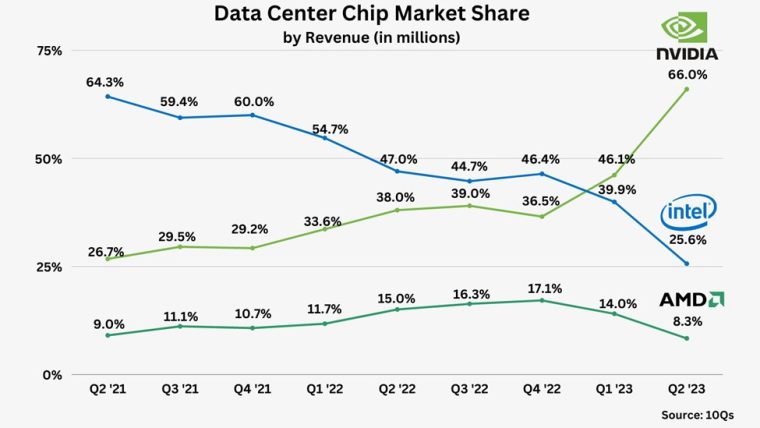Intel’s net worth is currently $107.26 billion; 48% down from January 2024.
With its stock value plummeting by half in 12 months and dipping to a 10-year low in August, it’s fair to say that this has been a poor year for the tech company. Although Intel still holds a majority market share in the computer CPU market, it has struggled to gain a foothold in the generative AI market and is losing out to competitors like Nvidia.
This Business2Community article explores the factors behind Intel’s successes and failures, looking at key financial performance metrics, investments, and missed opportunities to understand how Intel has reached its current position in the market.
Intel Key Company Data
Intel Net Worth: $107.26 billion
Date Founded: July 1968
Founded By: Robert Noyce and Gordon Moore
Current CEO: Pat Gelsinger
Industries: Technology, semiconductors, AI
Intel Corporation Stock Ticker: NASDAQ: INTC
Dividend Yield: 2%
What is Intel’s Net Worth?
Technology company Intel’s net worth is $107.26 billion. This value, also known as Intel’s market cap, has fallen by around 60% in the past five years and is just one-fifth of its peak of over half a trillion dollars achieved in 2000 during the dotcom bubble.
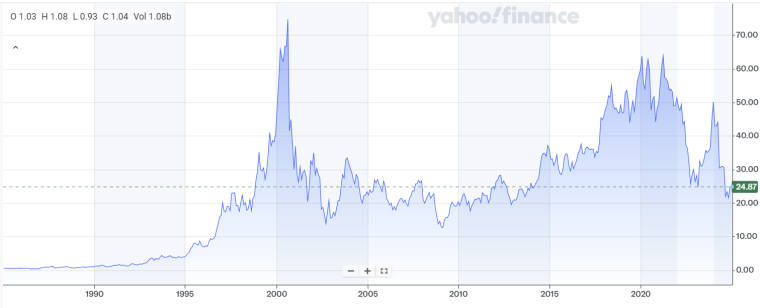
At its IPO on October 13, 1971, three years after the company was founded, Intel raised $6.8 million from the sale of 350,000 shares priced at $23.50.
As the manufacturer of the world’s first programmable microprocessor, and at the forefront of subsequent semiconductor innovation, Intel quickly became integral to the fast-growing personal computer market.
Intel saw rapid growth in the late 1990s, with its value almost doubling in the first 8 months of 2000 from $274 billion to $502 billion. Soon after, the dotcom bubble burst and Intel’s net worth fell as quickly as it had risen.
The 2010s marked a slow but steady recovery, but Intel had already dismissed the opportunity to supply processors for the original iPhone, having wildly underestimated the smartphone market. Outgoing CEO Paul Otellini admitted in a 2013 interview that things would have been “a lot different” if Intel had secured the deal.
Intel has been slow to innovate in the era of AI as demand for processors and data center chips has soared. Nvidia overtook Intel as the most valuable chipmaker in July 2020 and had secured a 66% market share by mid-2023.
2024 has been a particularly poor year for Intel, with its net worth falling 48% from $202.8 billion at the beginning of the year.
When Intel posted its Q2 2024 earnings, missing analyst expectations and recording a $1.6 billion loss for the quarter, its stocks fell by 30% in a week. This culminated in its share prices hitting a 10-year low of $18.95 in August, making it the worst-performing constituent of the Dow Jones Industrial Average (DJIA).
On November 8, 2024, it was announced that Intel would lose its spot on the index – which it had held for 25 years – and be replaced by rival semiconductor company Nvidia.
Intel’s fiscal year runs from January 1 to December 31. The company publishes its annual reports around January 26 the following year.
Intel Revenue
Intel’s revenue in FY2023 was $54.2 billion; a 10-year low for the company and a 14% year-on-year decline.
Intel reports revenue in the following segments:
- Client computing group (CCG) – Intel Core processors for desktop and notebook; wireless connectivity products
- Data centers and AI – Intel Xeon processors and other AI solutions
- Network and edge – Hardware and software platforms and tools for AI integration and operating efficiency
- Mobileye – Autonomous driving technology
- Intel foundry services – Manufacturing of chips and other technologies
For FY2023, Intel’s income was broken down by segment as follows:
- Client computing: $29.3 billion
- Desktop: $10.2 billion
- Notebook: $17.0 billion
- Other: $2.1 billion
- Data center and AI: $15.5 billion
- Network and edge: $5.8 billion
- Mobileye: $2.1 billion
- Intel foundry services: $1.0 billion
Although client computing accounts for 54% of Intel’s revenue, income from this segment has dropped 29% in just two years because of lower demand in the consumer and education markets.
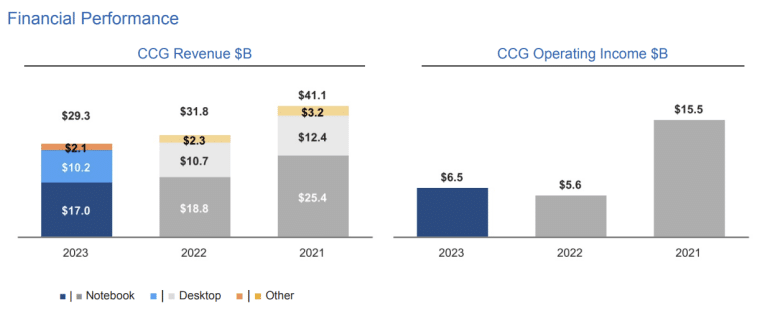
Intel’s data center and AI revenues have also flopped in the past two years, falling 31% from 2021. Intel attributes this to rising unit costs and lower product margins due to reduced demand in a softening market.
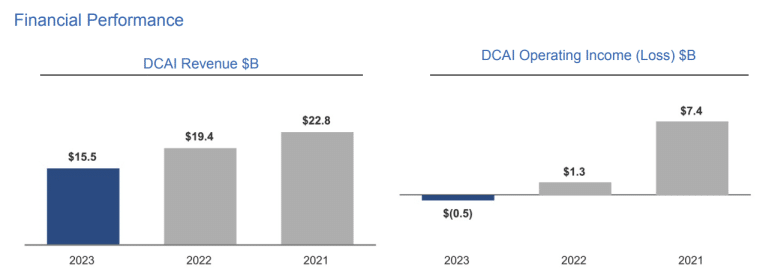
Here is Intel’s full revenue history for the past 10 years:
| Year | Revenue ($ billions) |
| 2014 | 55.870 |
| 2015 | 55.355 |
| 2016 | 59.387 |
| 2017 | 62.761 |
| 2018 | 70.848 |
| 2019 | 71.965 |
| 2020 | 77.867 |
| 2021 | 79.024 |
| 2022 | 63.054 |
| 2023 | 54.228 |
Intel’s Q3 2024 earnings report revealed revenue of $13.3 billion with a net loss of $16.6 billion. This loss was mainly attributable to $15.9 billion of impairment charges and $2.8 billion of restructuring charges as part of a major restructuring and cost-reduction program.
Despite these losses, CFO David Zinsner said the company was “encouraged by improved underlying trends” in the quarter.
Intel Dividend History
Intel is currently not paying dividends to shareholders. The company announced in its Q2 2024 earnings release that it was pausing dividend payments as it recognized “the importance of prioritizing liquidity to support the investments needed to execute our strategy”.
Prior to this, Intel had paid a quarterly dividend of $0.125 per share. This amount was cut from $0.365 per share in Q2 2023, and was the lowest dividend paid since 2008.
Here are details of Intel dividends for the past 10 years:
| Payment Date | Dividend Amount ($) |
| 2024-09-01 | 0.125 |
| 2024-06-01 | 0.125 |
| 2024-03-01 | 0.125 |
| 2023-12-01 | 0.125 |
| 2023-09-01 | 0.125 |
| 2023-06-01 | 0.125 |
| 2023-03-01 | 0.365 |
| 2022-12-01 | 0.365 |
| 2022-09-01 | 0.365 |
| 2022-06-01 | 0.365 |
| 2022-03-01 | 0.365 |
| 2021-12-01 | 0.3475 |
| 2021-09-01 | 0.3475 |
| 2021-06-01 | 0.3475 |
| 2021-03-01 | 0.3475 |
| 2020-12-01 | 0.33 |
| 2020-09-01 | 0.33 |
| 2020-06-01 | 0.33 |
| 2020-03-01 | 0.33 |
| 2019-12-01 | 0.315 |
| 2019-09-01 | 0.315 |
| 2019-06-01 | 0.315 |
| 2019-03-01 | 0.315 |
| 2018-12-01 | 0.3 |
| 2018-09-01 | 0.3 |
| 2018-06-01 | 0.3 |
| 2018-03-01 | 0.3 |
| 2017-12-01 | 0.2725 |
| 2017-09-01 | 0.2725 |
| 2017-06-01 | 0.2725 |
| 2017-03-01 | 0.26 |
| 2016-12-01 | 0.26 |
| 2016-09-01 | 0.26 |
| 2016-06-01 | 0.26 |
| 2016-03-01 | 0.26 |
| 2015-12-01 | 0.24 |
| 2015-09-01 | 0.24 |
| 2015-06-01 | 0.24 |
| 2015-03-01 | 0.24 |
Intel has carried out 8 stock splits in its history as a public company, the most recent one on July 31, 2000. The cumulative multiple from these splits is 192x.
| Date | Split | Multiple | Cumulative Multiple |
| 07-31-2000 | 2:1 | x2 | x192 |
| 04-12-1999 | 2:1 | x2 | x96 |
| 07-14-1997 | 2:1 | x2 | x48 |
| 06-19-1995 | 2:1 | x2 | x24 |
| 06-07-1993 | 2:1 | x2 | x12 |
| 10-29-1987 | 3:2 | x1.5 | x6 |
| 07-01-1983 | 2:1 | x2 | x4 |
| 10-09-1980 | 2:1 | x2 | x2 |
Intel launched an accelerated share repurchase agreement in 2020 under which it could repurchase $10 billion of common stock. However, Intel’s last stock buyback was on June 30, 2021, and there is currently $7.24 billion outstanding from this program.
Here are details of the last 10 Intel stock repurchases:
| Date | Value ($ millions) |
| 06/30/2021 | 114 |
| 03/31/2021 | 2,301 |
| 09/30/2020 | 10,000 |
| 03/31/2020 | 4,229 |
| 12/31/2019 | 3,476 |
| 09/30/2019 | 4,521 |
| 06/30/2019 | 3,049 |
| 03/31/2019 | 2,530 |
| 12/31/2018 | 2,266 |
| 09/30/2018 | 2,657 |
Who Owns Intel?
Intel Corporation is owned by a mix of institutional investors and individual stakeholders. The major institutional investors in the publicly traded company include BlackRock (8.92%), The Vanguard Group, Inc. (8.42%), and State Street (4.59%).
Intel went public with its initial public offering (IPO) on October 13, 1971. The offering included 350,000 shares, priced at $23.50 each, raising a total of $6.8 million. Intel employees and original shareholders had 2.2 million shares, in contrast to the 350,000 shares offered in the IPO.
In January 2024, Intel’s stock was valued at $48 per share.
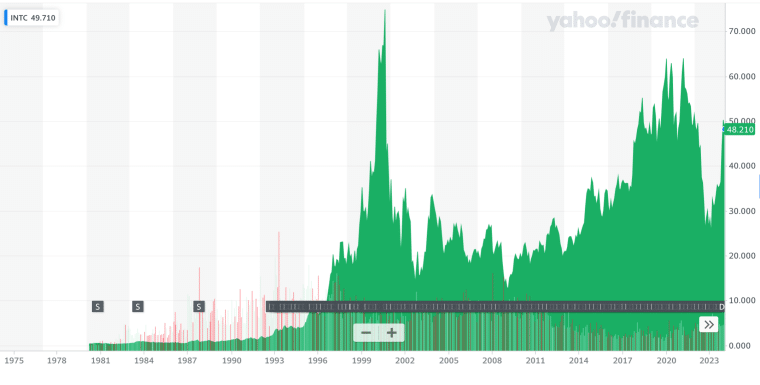
Who Founded Intel?
Robert Noyce and Gordon Moore founded Intel on July 18, 1968. The founders wanted to innovate and revolutionize the semiconductor industry, particularly by introducing microprocessors that would become fundamental to modern computing.
Originally named “NM Electronics“ after founders Robert Noyce and Gordon Moore, the company had a name change a month later.
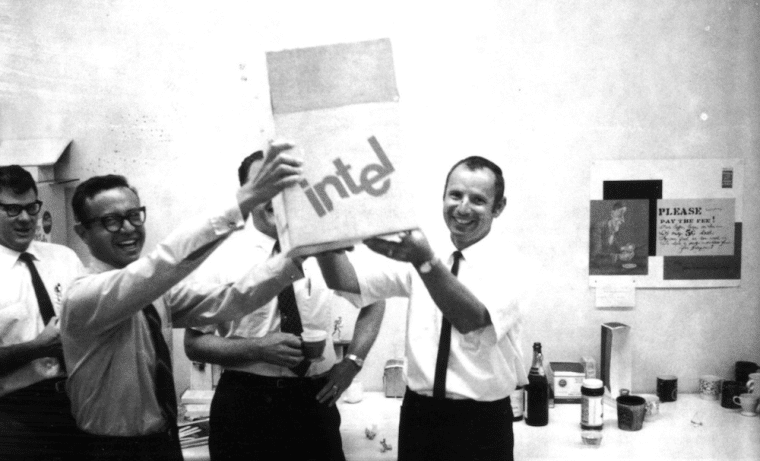
“Intel,” short for Integrated Electronics, came about through a $15,000 deal to acquire naming rights from a hotel chain called Intelco.
Arthur Rock was the first investor to secure funding for Intel. He helped the company raise $2.5 million by issuing convertible debentures, therefore providing the financial foundation Intel needed.
Who is Intel’s CEO?
Patrick Gelsinger has been the CEO and president of Intel Corporation since 2021. Gelsinger began his career at Intel as an 18-year-old quality control technician in 1979.
Under his guidance, Intel has launched key technologies such as the original 80486 processor and the USB. Additionally, Gelsinger oversaw the development of the IEEE 802.11 standards, which form the basis for WiFi networks.

Over the decades, Intel has been led by a succession of influential CEOs, each contributing to the company’s growth and innovation.
Here is a list of Intel’s CEOs from its founding in 1968 to the most recent leadership transitions:
| CEO | Years in Position |
| Robert Noyce | 1968–1975 |
| Gordon Moore | 1975–1987 |
| Andy Grove | 1987–1998 |
| Craig Barrett | 1998–2005 |
| Paul Otellini | 2005–2013 |
| Brian Krzanich | 2013–2018 |
| Robert Swan | 2019–2021 |
| Patrick Paul Gelsinger | 2021–Present |
Growth and Development of Intel
As of January 2024, Intel had a market cap of $203 billion, making it one of the largest semiconductor companies in the world.
Intel has evolved into a technological juggernaut, offering a diverse range of services and products such as microprocessors and memory solutions to AI, IoT, and autonomous driving technologies, showcasing its commitment to innovation.
How did Intel CPUs become a leader in semiconductors and other tech areas? Let’s take a look at Intel’s history and explore the key milestones to see how this happened.
A History of Intel – Key Dates
- Robert Noyce and Gordon Moore founded Intel on July 18, 1968.
- Intel had its IPO on October 13, 1971.
- The world’s first programmable microprocessor was created by Intel.
- Intel achieved its highest-ever revenue of $79 billion in 2021.
- The Client Computing segment is Intel’s primary revenue generator.
1960s: Intel’s Founding and Early Years
In 1968, Robert Noyce, Gordon Moore, and Andy Grove left Fairchild Semiconductors, paving the way for the founding of Intel.

In its early years, Intel focused on research and development with the goal of pioneering technologies that were distinct from what others offered. Intel began its operations on August 1st, 1968 from a conference room located within the old Union Carbide building on Middlefield Road in Mountain View, California. Intel had 106 employees working at the Mountain View Facility by 1969.
In October 1968, Intel established a small laboratory to manufacture zinc sulfide light-emitting diodes (LED), expanding the LED spectrum beyond red. The innovation was subsequently sold to Monsanto in 1969.
Intel lost $446,000 in its first year of business. The operations statement for the year said the losses were due to heavy investment in R&D that would eventually pay off over the years.
In 1969, Intel debuted its first product, the 3101 Schottky bipolar random-access memory (SRAM) chip. Its 64-bit design improved storage and retrieval capabilities.
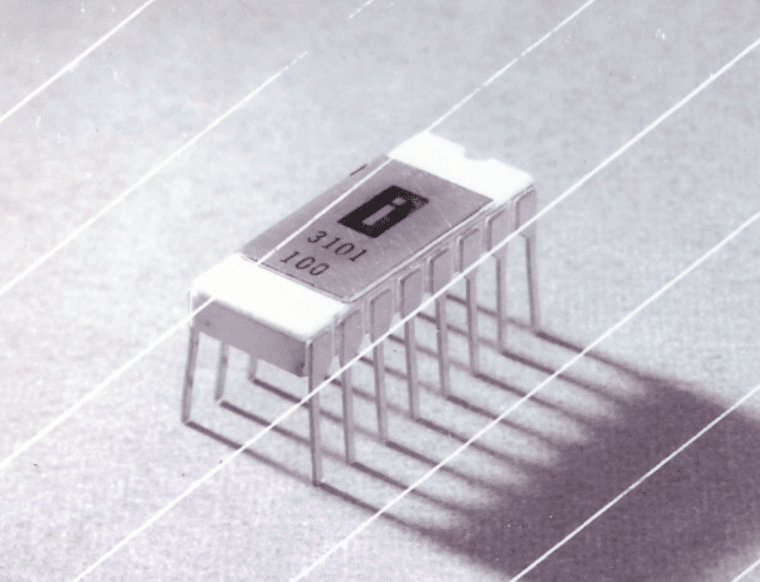
Intel also introduced the first commercial 1101 SRAM chip, with advancements in metal oxide semiconductors and silicon gates. The company began manufacturing Intel chips on silicon wafers that same year, which are thin, flat discs of silicon material, increasing production efficiency.
Intel made its first sale in July 1969 to Hamilton Electro Sales.
1970s – Intel Revolutionizes The Semiconductor Industry
In 1970, Intel achieved $3.9 million in net sales. Despite facing a loss of almost $1 million, the year marked a breakthrough with the launch of several innovative semiconductors.
The company created the 1103 dynamic random-access memory (DRAM) in October 1970, replacing magnetic core memories with semiconductors which offered greater efficiency and cost-effectiveness compared to magnetic core memories. By 1972, 14 out of the 18 mainframe computer manufacturers in the US, Europe, and Japan depended on the 1103, making it the world’s top-selling semiconductor device.
In 1971 Intel created the 1702. It was the world’s first erasable programmable read-only memory (EPROM). This innovation demonstrated reprogramming capabilities and was a significant advancement for memory technology.
The first Intel Chip released in November 1971, was the world’s first programmable microprocessor designed for use in a Japanese Busicom calculator. The 4004 was quickly followed by the 8008 five months later.
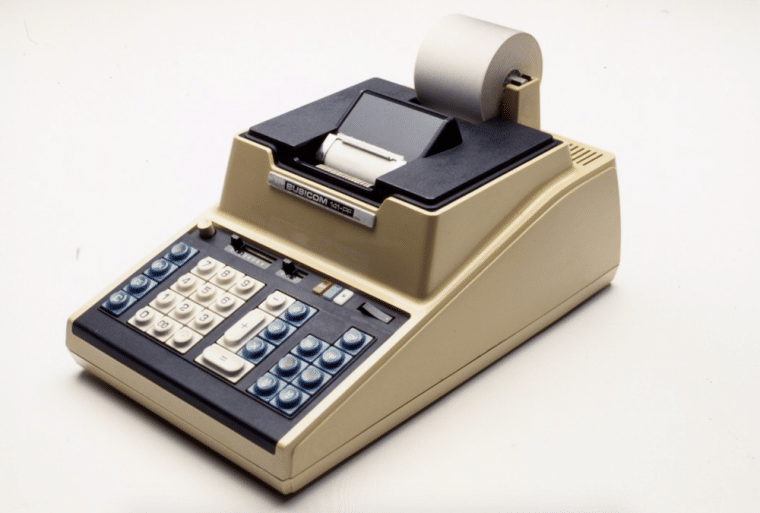
Intel invested $1.2 million into its first international manufacturing facility in Penang, Malaysia in 1971. The construction of Intel Malaysia concluded in 1973. In 1974, Intel opened its first design center in Israel, and also became the first US semiconductor facility in the Philippines with an assembly plant in Manila.
The 1974 Intel 8080 represented a major advancement over the Intel 4004 and 8008, mainly because it was designed to operate independently. The Altair 8800 played a key role in Intel’s success by using the Intel 8080, establishing Intel microprocessors as leaders in the emerging personal computer industry.
In 1976, Intel introduced the MCS-48 microcontroller series, combining microprocessors, memories, and input/output in a single package.
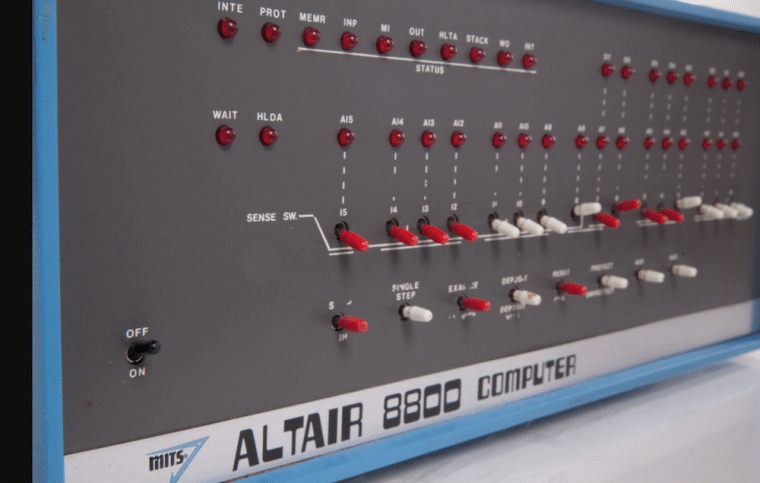
The Intellec software series debuted in June 1973, assisting engineers and developers in designing, testing, and debugging software for Intel’s microprocessor products.
By the end of the 1970s, Intel reported a revenue of $660.9 million, largely attributed to the 8086 series. The company’s decade was further underscored by its inclusion in the Fortune 500 list for business successes in the 1970s.
1980s – Intel Dominates the PC Market
Intel entered the PC market in 1981 in collaboration with the release of IBM PCs. The IBM PC used the 8088 Intel microprocessor, an 8-bit variant of the 16-bit 8086. IBM choosing Intel’s processor set the standard for other manufacturers, contributing to the widespread adoption of Intel’s x86 core microarchitecture.
In 1984 Intel’s 80286 – the “286” – processor was used as the CPU for IBM’s second-generation PC. The 286, with triple the performance of other 16-bit processors, pioneered multitasking, optimized operations for speed, and supported diverse operating systems.
Intel processors evolved into a full computer operating system in the 80s when the company launched System 86/330. The setup included a single-board computer, disk drives, software interfaces, power supply, and chassis as integral components. Introduced in 1982, the Intel Personal Development System was the first portable development system for 8-bit microprocessor and microcontroller design. It included a monitor, attached keyboard, disk drive, and input/output functions.
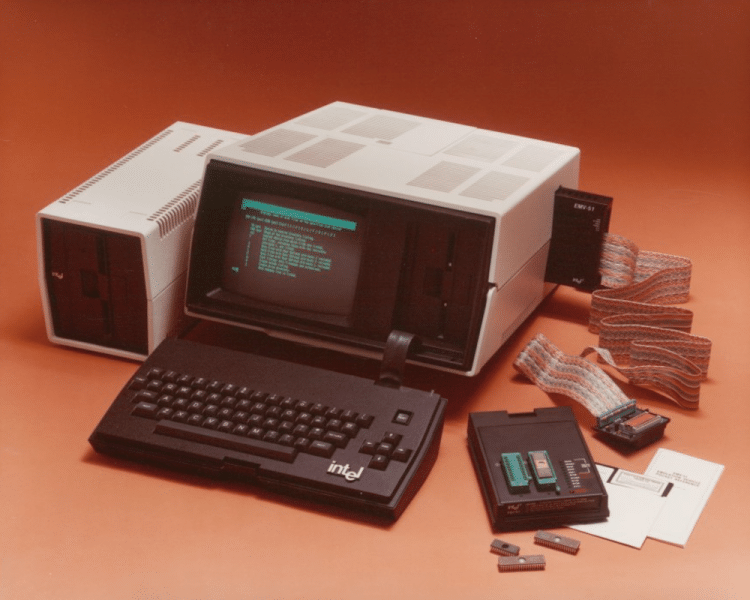
In 1983, Intel achieved $1 billion in annual revenue, driven by factors such as high demand for personal computers, successful product offerings, strategic partnerships, technological innovation, and a global business strategy.
By 1984, Intel’s Electronic Engine Control-IV (EEC-IV) automotive chip had been integrated into all Ford Motors. Moreover, by 1988, Intel had effectively supplied 20 million EEC-IV components to Ford. The same year Intel released the 82526 “286”, the first device to establish a controller area network (CAN), enabling the integration of a car’s engine control, braking, steering, and other essential functions.
The 1984 Semiconductor Chip Protection Act significantly shielded Intel’s semiconductor chips, safeguarding the company’s advanced designs from unauthorized reproduction or use.
The company launched the Intel 80386 “386” microprocessor in 1985 signifying an advancement in personal computing. Its most notable feature was the transition from a 16-bit architecture to a more powerful 32-bit architecture.
The Intel Foundation was established in June 1988. The foundation was created as a means for Intel to contribute to societal and educational advancement, reflecting the company’s dedication to corporate social responsibility.
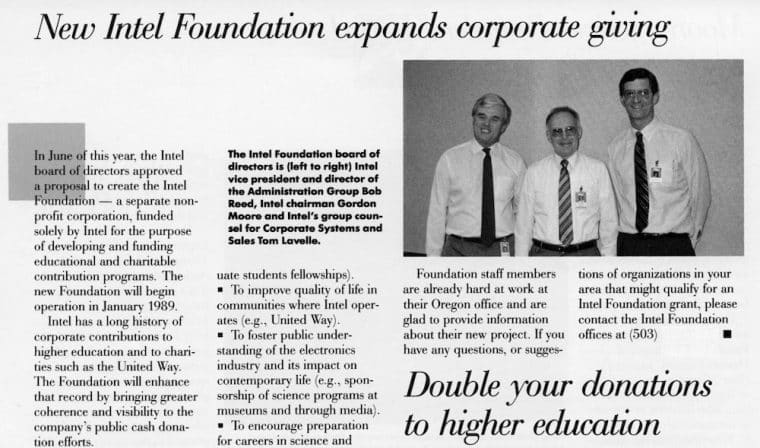
In 1989, the company unveiled three groundbreaking Intel processors that established a unified hardware and software standard for parallel computing:
- i860
- i486
- i960
1990s – Intel’s Product Diversification and Globalization
In 1990, Intel entered the communications and network sphere with the introduction of NetPort servers. These servers facilitated the connection of printers to computers through local area networks (LAN).
The introduction of the i750 video processor opened the way for Intel technology in the multimedia industry. With Intel’s two silicon semiconductor chips, personal computers could create and edit multimedia with digital video and stereo sound.
The 1991 Intel Inside campaign clarified for computer users the role of a processor in personal computers and emphasized the significance of using Intel processors. The Intel Inside campaign eventually evolved into The Intel Inside Program which educated computer users with ads and product labels that Intel manufactured the “brains” fueling their personal computer.
Consequently, the success of the Intel Inside campaign brought an annual revenue that year exceeding the previous year by almost $1 billion, surpassing $4 billion for the first time.
In 1993 Intel introduced The Pentium, its fifth-generation x86 chip, outperforming the i486 and the original 8088 in the IBM PC. The Pentium processor, complying with a legal requirement, marked Intel’s first named chip with a letter. The Pentium Pro, targeting professionals and the server market, emerged in 1995. In 1997, the Pentium II, 36% more powerful than its predecessor, represented a quarter of Intel’s microprocessor production.
The late 90s brought the Pentium III, emphasizing internet-related capabilities, and advancing performance in imaging, 3D, and streaming applications.
In 1994, Intel drafted the first-ever USB, introducing the concept of Plug and Play. It allowed users to connect devices to a port without needing to buy additional hardware for their personal computers. Subsequently, the first USB (Version 1.1) was released in September 1998.
Intel released its first website and joined the global network of the world wide web in 1995, representing Intel’s acknowledgment of the growing importance of the internet as a communication and information-sharing platform. Furthermore, this move allowed Intel to provide online resources, and information about its products, and engage with a broader audience.
2000s – Intel’s Challenges and Innovations
With the increasing intelligence of wireless digital devices such as cell phones and personal digital assistants, Intel’s innovative XScale microarchitecture development helped advance processing power and battery life in the 2000s.
In 2001 Intel announced the release of The Itanium Architecture 64. It could manage scientific calculations, stock trading, airline reservations, and secure online transactions. The Itanium 2 was designed in 2002 for data-intensive business and technical computing applications.
Intel invested $2 billion in the Fab 11X New Mexico manufacturing facility in 2002. As of January 2024, Fab 11X continues to operate as one of Intel’s advanced manufacturing facilities.
Centrino Mobile Technology was a platform introduced by Intel in 2003 to provide a solution for mobile devices, specifically for laptops and notebooks. The Centrino brand represents a combination of three key components:
- Processor
- Chip
- Wireless networking
Intel’s “One Unwired Day” promoted the company’s efforts and showcased the benefits of wireless technology. Individuals and businesses were encouraged to try Centrino mobile processors and Intel offered free public WiFi access spots across the US.
In 2004, Intel announced the 90nm Flash flash memory technology. This advancement, with components 50% smaller than the previous generation. Crafted for the wireless market, it showcased Intel’s dedication to pushing semiconductor manufacturing boundaries.
In 2005 the Pentium D series brought dual-core technology to the mainstream desktop market. Then Intel announced its new Intel Core processors in 2006. They were based on the new Intel Core microarchitecture, which replaced the previous NetBurst microarchitecture used in Pentium 4 processors.

Intel Core processors became a prominent part of Intel’s processor nomenclature. The Intel Core brand has been applied to subsequent generations of processors, including Core i3, Core i5, and Core i7.
In 2006 Apple began adding Intel processors to Macintosh computers. As Apple’s CEO Steve Jobs said:
It’s been ten years since our transition to the PowerPC, and we think Intel’s technology will help us create the best personal computers for the next ten years.
However, in 2020, the 15-year partnership came to an end, as Apple revealed plans to transition its Mac lineup from Intel processors to Apple silicon.
Introduced in 2008, the Intel Atom processor family revolutionized mobile and compact computing with its compact size and energy efficiency.
2010s – Collaborations and Emerging Technologies
Intel created Thunderbolt technology in collaboration with Apple in 2011 for fast data transmission between devices.
The release of Ultrabooks in 2011 redefined Intel’s personal computer category. It was the first time that Intel developed a commercially successful consumer electronics product.
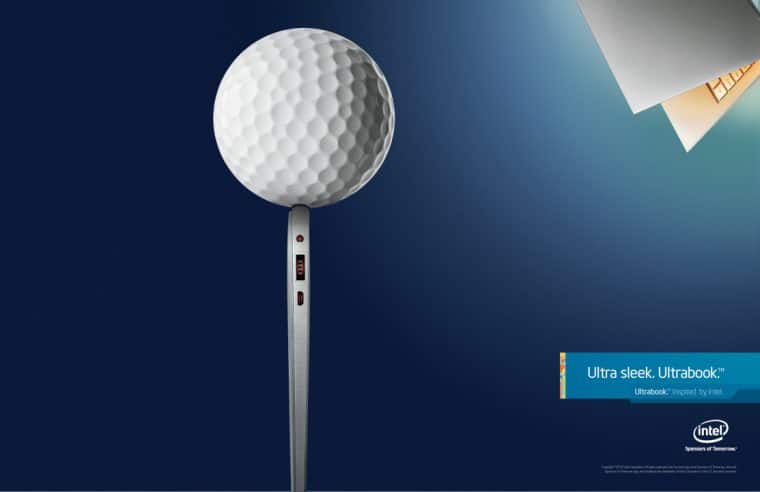
Intel acquired the wireless solutions business of Infineon for approximately $1.4 billion and formed its Mobile Communications Group that same year.
In 2012 the company created Xeon Phi, a family of Intel processors designed for high-performance computing tasks. For example, they were able to predict 21-day weather forecasts and find new cures for diseases.
Intel’s acquisition of Altera Corp for more than $16 billion in 2015 facilitated the significant expansion of new products in the internet of things (IoT) and data center market segments. Concurrently, Intel processors entered the drone industry, achieving a Guinness World Record for the “most unmanned aerial vehicles airborne simultaneously.”
Capitalizing on this success, Intel announced the release of the Falcon 8+, its first drone designed for the commercial market in 2016. In 2017, Intel ventured into the autonomous vehicles industry with the successful $15 billion acquisition of Mobileye. By 2018, Intel introduced its first fleet of self-driving cars, consisting of 100 Ford Fusions.
Intel achieved over $70 billion in revenue that year, driven by an 18% growth in its data-centric businesses.
Launched in 2019 in collaboration with industry partners, Project Athena helped Intel create laptops with enhanced performance and portability, delivering an exceptional computing experience for users.
2020s: Intel Adapts to a New Era
The company’s commitment to innovation was exemplified by its continuous investment in research and development. In 2022, Intel allocated $17.53 billion to R&D, an increase of $2.3 billion compared to the previous year.
In 2020 Intel in partnership with Lenovo, introduced the ThinkPad X1 FOLD, the first commercially available device featuring a foldable screen.
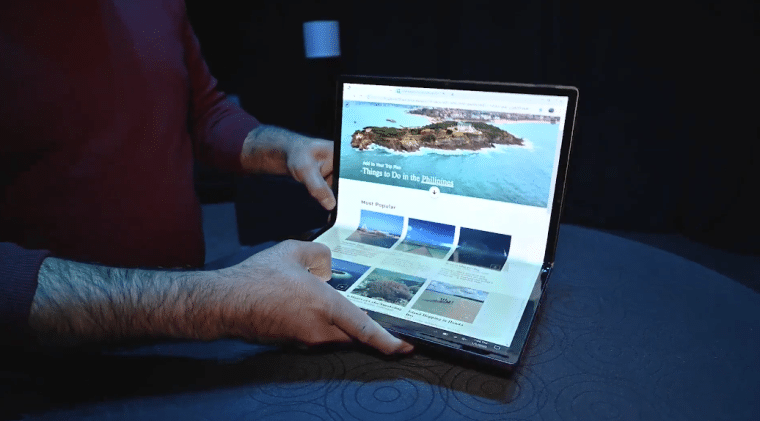
By December 2023, Lenovo and Intel had released a new lineup of laptops powered by Intel Core Ultra processors, unlocking advanced AI experiences. This includes models like the ThinkPad X1 Carbon, ThinkPad X1 2-in-1, and IdeaPad Pro 5i.
Amid the COVID-19 pandemic, Intel launched a $50 million Pandemic Response Technology Initiative, supporting 230 global projects. Moreover, the paradigm shift towards remote work and learning boosted demand for Intel technology, leading the company to achieve its highest-ever revenue of $79 billion in 2021.
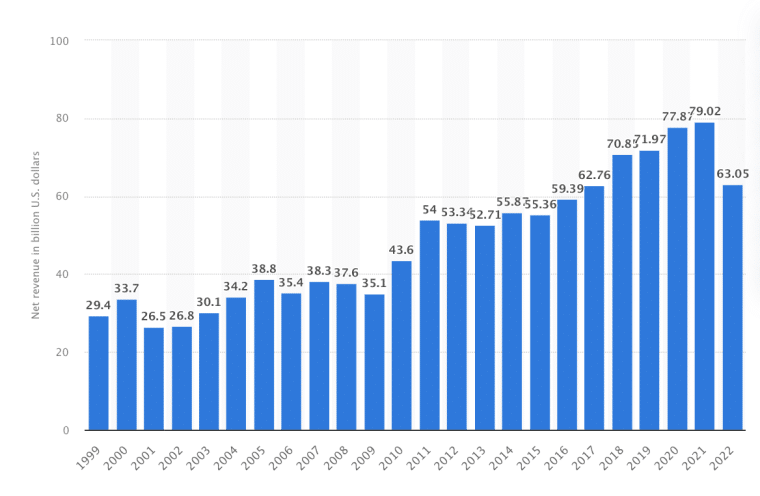
What Products and Services Does Intel Provide?
Intel’s organizational structure is divided into six distinct business groups, each focusing on specific industry segments:
| Intel Segment | Purpose |
| Client Computing Group | Provides processors and technologies for personal computers in the consumer market. |
| Datacenter & AI Group | Advances in data center products, including Xeon servers and FPGA products, with a focus on AI. |
| Network & Edge Group | Develop solutions and innovations that enhance connectivity and computing capabilities at the network’s edge. |
| Accelerated Computing Systems and Graphics Group | Focus on high-performance computing and graphics solutions across various sectors. |
| Intel Foundry Services | Standalone foundry business offering manufacturing services. |
| Mobileye Group | Develop driving assistance and self-driving solutions. |
Intel’s Client Computing segment stands out as the primary revenue generator for the company. In 2022, this segment contributed $31.71 billion to Intel’s total revenue.
Following behind, the Data Center and AI segment added $19.2 billion, and the Network and Edge segment accounted for $8.87 billion.
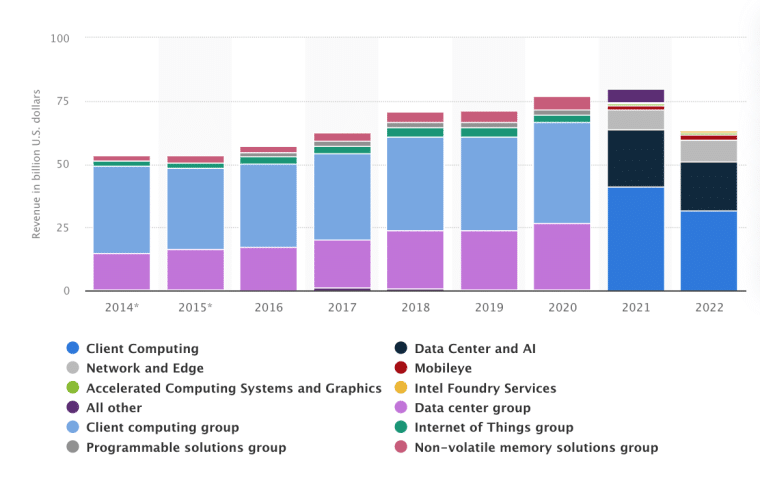
Transitioning to Q3 2023, Intel reported a total revenue of $14.2 billion. In this period, Client Computing maintained its lead with $7.9 billion, followed by the Data Center and AI segment with $3.8 billion, and the Network and Edge segment contributing $1.5 billion.
In January 2024, Intel announced the creation of Articul8 AI, a new company solely focused on generative AI. This strategic initiative, developed in collaboration with DigitalBridge Group, aligns with the company’s commitment to advancing AI capabilities across diverse applications and industries.
History of The Intel Logo
The first Intel logo was created by founders Robert Noyce and Gordon Moore in 1969. The simple design featured the company’s name, Intel, with a “dropped e”. The logo was first advertised in a newspaper during the release of Intel’s first microprocessor, the 3101 chip.
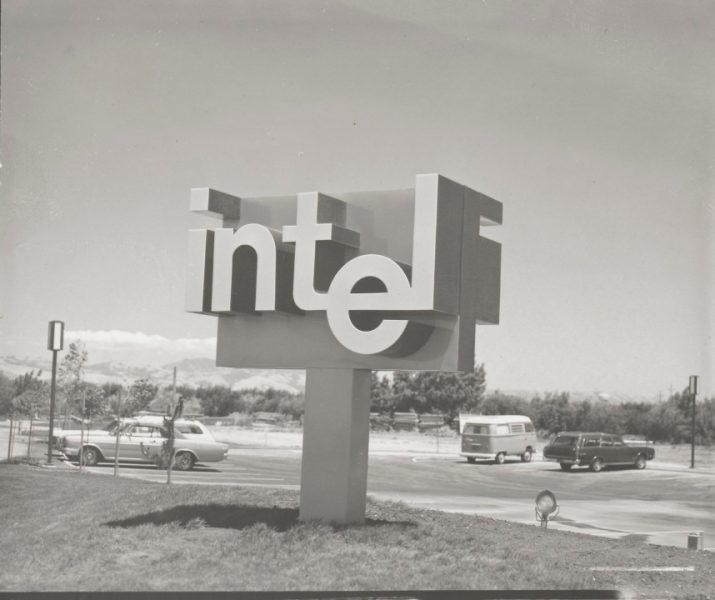
In 1991 Intel created a separate Intel Inside sticker logo to feature on products and align with its advertising campaign. Intel’s strategy helped consumers familiarize themselves with Intel’s processors and understand what is inside their computers.
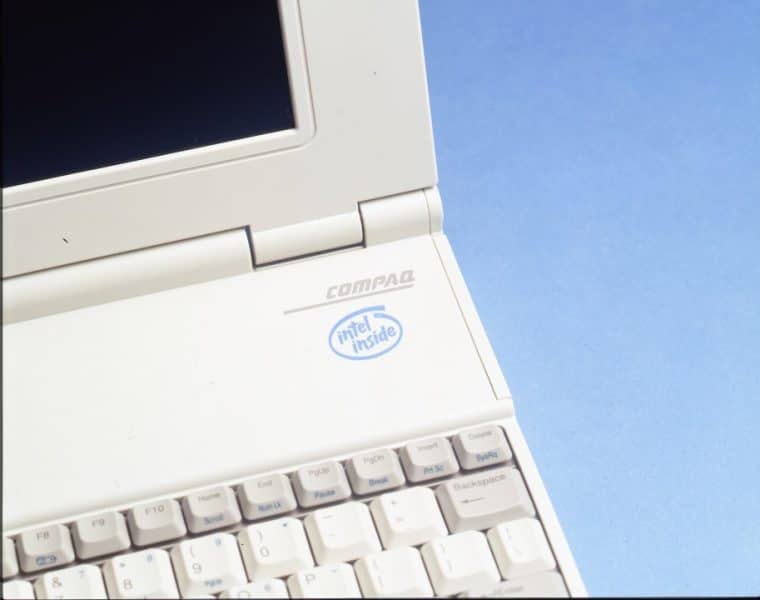
Intel said farewell to its dropped “e” logo in 2006. The new logo showcased a vortex graphic encircling the word “Intel”, reminiscent of the iconic Intel Inside sticker. The rebranding also included a new tagline: “Intel. Leap ahead”
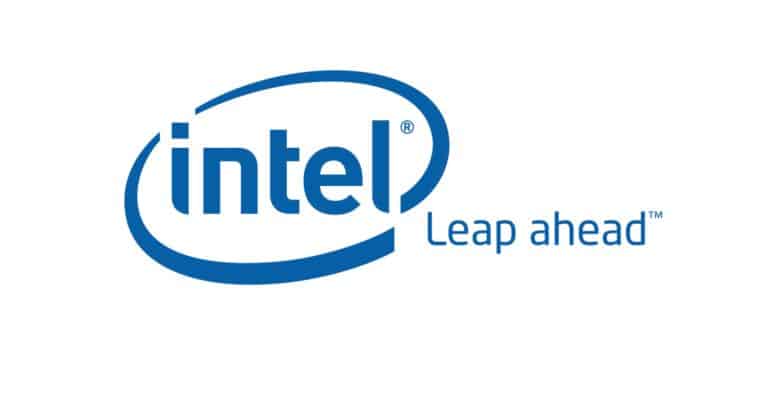
Intel had its third logo redesign in 2020, adopting a simpler typeface with brighter colors. The updated design eliminated the circular vortex graphic, retained lowercase letters, and featured the distinctive square-capped “i”.
The Future of Intel
Intel will embrace the new era of AI by integrating innovative capabilities into its processors and hardware products, with a vision to make these features widely accessible through open, multi-architecture software solutions.
Initiatives like the establishment of Articul8 AI showcase the company’s ongoing evolution, building upon a rich history of technological advancements.
The journey from the birth of the first microprocessor to the forefront of artificial intelligence underscores Intel’s commitment to pushing boundaries and shaping the technology industry. The future holds the promise of additional innovative solutions and transformative breakthroughs from this iconic semiconductor pioneer.

